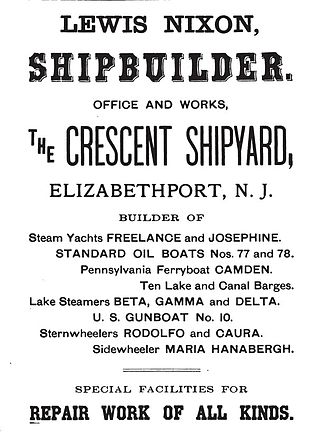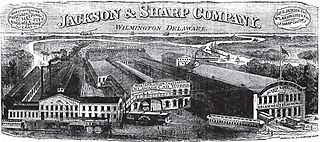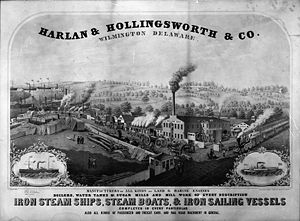
USS Algonquin, completed as El Toro in 1891 for the Southern Pacific Railroad's Morgan Line, was a small harbor tug commissioned by the United States Navy 2 April 1898. Renamed Accomac, after Accomac, Virginia, June 1898, renamed Nottoway in 1918 and, after the Navy adopted alphanumeric hull numbers on 17 July 1920, classified as YT-18, a district tug. On 5 October 1942 the name was cancelled and the tug was simply YT-18 until 1944 when classification was changed to YTL-18, a little harbor tug. Over the years as a Navy tug, from 1898 to 1946, the tug served from Cuba to Boston.

Crescent Shipyard, located on Newark Bay in Elizabeth, New Jersey, built a number of ships for the United States Navy and allied nations as well during their production run, which lasted about ten years while under the Crescent name and banner. Production of these ships began before the Spanish–American War and occurred far before the outbreak of World War I. Arthur Leopold Busch, a recent emigre from Great Britain, started the yard with former Navy Lt. Lewis Nixon in January 1895. Both men previously worked for William Cramp & Sons in Philadelphia. Both Nixon and Busch were regarded to be amongst the best in their respected fields - and what they did at this time - as designers and builders of the latest, most advanced types of ships.

Union Iron Works, located in San Francisco, California, on the southeast waterfront, was a central business within the large industrial zone of Potrero Point, for four decades at the end of the nineteenth and beginning of the twentieth centuries.

Bethlehem Steel Corporation Shipbuilding Division was created in 1905 when the Bethlehem Steel Corporation of Bethlehem, Pennsylvania, acquired the San Francisco-based shipyard Union Iron Works. In 1917 it was incorporated as Bethlehem Shipbuilding Corporation, Limited.

USS Aquamarine (PYc-7) was the former yacht Siele launched in April 1926 by Pusey and Jones Corporation, Wilmington, Delaware. In 1940 Siele was sold and renamed Sea Wolf which was purchased by the Navy in January 1941 and commissioned Aquamarine in April. Though given a "patrol yacht, coastal" designation the yacht was assigned to the Naval Research Laboratory for acoustical research during World War II. After naval service the yacht was again under the name Sea Wolf until sold in 1954 and renamed Miss Ann, listed on the U.S. National Register of Historic Places in 1998.

The Arkansas and Missouri Railroad is a Class III short-line railroad headquartered in Springdale, Arkansas.

The Harlan and Hollingsworth Office Building is a historic office building located in Wilmington, New Castle County, Delaware. It was completed in 1912, and stands on the corner of West St. and the Wilmington Rail Viaduct. It is a three-story, detached, rectangular brick-faced building with two small rear wings in the Colonial Revival style. It features two large, decorated copper-faced bay windows projecting from each face of the right corner of the second story.

Neafie, Levy & Co., commonly known as Neafie & Levy, was a Philadelphia, Pennsylvania shipbuilding and engineering firm that existed from the middle of the 19th to the beginning of the 20th century. Described as America's "first specialist marine engineers", Neafie & Levy was probably the first company in the United States to combine the building of iron ships with the manufacture of steam engines to power them. The company was also the largest supplier of screw propellers to other North American shipbuilding firms in its early years, and at its peak in the early 1870s was Philadelphia's busiest and most heavily capitalized shipbuilder.

Jackson and Sharp Company was an American railroad car manufacturer and shipbuilder in the late 19th and early 20th centuries. The company was founded in 1863 by Job H. Jackson, a tinsmith and retail merchant, and Jacob F. Sharp, a carpenter who had worked for rail car manufacturers and shipbuilders.
The Pusey and Jones Corporation was a major shipbuilder and industrial-equipment manufacturer. Based in Wilmington, Delaware, it operated from 1848 to 1959.

The Pennsylvania class was a class of four cargo-passenger liners built by the Philadelphian shipbuilder William Cramp & Sons in 1872–73. Intended for the newly established American Line, the four ships—Pennsylvania, Ohio, Indiana and Illinois—were at the time the largest iron ships yet built in the United States, and were launched with considerable fanfare. Upon entering service in 1874, they became the first American-built steamships to challenge British dominance of the transatlantic trade since the American Civil War.
Reaney, Son & Archbold was a 19th-century American iron shipbuilding company located on the Delaware River at Chester, Pennsylvania. The company was established in 1859 by Thomas Reaney but it was undercapitalized from the outset, and like many other American shipbuilding companies, fell victim to the shipbuilding slump that followed the American Civil War.
The Delaware River Iron Ship Building and Engine Works was a major late-19th-century American shipyard located on the Delaware River in Chester, Pennsylvania. It was founded by the industrialist John Roach and is often referred to by its parent company name of John Roach & Sons, or just known as the Roach shipyard. For the first fifteen years of its existence, the shipyard was by far the largest and most productive in the United States, building more tonnage of ships than its next two major competitors combined, in addition to being the U.S. Navy's largest contractor. The yard specialized in the production of large passenger freighters, but built every kind of vessel from warships to cargo ships, oil tankers, ferries, barges, tugs and yachts.
John Roach & Sons was a major 19th-century American shipbuilding and manufacturing firm founded in 1864 by Irish-American immigrant John Roach. Between 1871 and 1885, the company was the largest shipbuilding firm in the United States, building more iron ships than its next two major competitors combined. It was also by far the largest contractor to the U.S. Navy during this period, and at its peak is said to have been the nation's largest employer behind the railroads.
Lawrence & Foulks was a 19th-century American shipbuilding company based in New York. Established in the early 1850s, the company built 144 vessels of all types over the course of some fifty years, but is best known for its production of high-speed wooden-hulled steamboats and steamships. Notable vessels built by the company include the record-breaking Hudson River steamboat Chauncey Vibbard, the luxury Long Island Sound steamer Commonwealth, and the fast oceangoing steamships—later U.S. Navy gunboats—Bienville and De Soto. In addition to the domestic market, the company also built ships for service as far afield as South America and China.
The United States Shipbuilding Company was a short-lived trust made up of seven shipbuilding companies, a property owner and steel company. Its stocks and bonds were unattractive to investors, and several of its member shipyards were overvalued, conditions which brought down the company less than a year after it was formed in 1902. The company was replaced by the Bethlehem Steel Corporation in 1904.
Mahlon Betts (1795–1867) was a carpenter, railroad car builder, shipwright, businessman, banker, and legislator who helped found three of Wilmington, Delaware's major manufacturing enterprises: the Harlan and Hollingsworth Company, the Pusey and Jones Company, and the Betts Machine Company.
The following is a timeline of the history of the city of Wilmington, Delaware, USA.

A. H. Bull Steamship Company was a shipping company and passenger liner service founded in New York City in 1902 by Archibald H. Bull (1848-1920). Service started with shipping between New York and Florida. His fleet of ships then added service to other Eastcoast ports. The company is also often called the Bull Lines and the Bull Steamship Line or A. H. Bull & Company. While founded in New York, Bull soon move its headquarter to Peir 5 in Baltimore, Maryland. Bull Lines main Eastcoast ports were: Baltimore, Charleston, Philadelphia, Tampa and Norfolk, Virginia. Oversea ports: Porto Rico, Antwerp, Bordeaux, Hamburg, Bremen, Copenhagen, and West Africa. Bull Steamship Line supported the US war effort for both World War I and World War II, including the loss of ships.

Bethlehem Key Highway Shipyard started as William Skinner & Sons in downtown Baltimore, Maryland in 1815. In 1899 the shipyard was renamed Skinner Shipbuilding & Dry Dock Company. Also at the site was Malster & Reanie started in 1870 by William T. Malster (1843–1907). In 1879 Malster partnered with William B. Reaney (1808-1883). In 1880 Malster & Reanie was sold and renamed Columbian Iron Works & Dry Dock Company. Malster & Reanie and Skinner Shipbuilding & Dry Dock Company merged in 1906, but remained as Skinner Shipbuilding. In 1914 the company was renamed Baltimore Dry Dock & Shipbuilding Company. Baltimore Dry Dock & Shipbuilding Company sold to Bethlehem Steel in 1922, becoming part of Bethlehem Shipbuilding Corporation. Bethlehem Steel operated the shipyard for ship repair, conversion and some ship construction. Bethlehem's main ship construction site was across the harbor at Bethlehem Sparrows Point. Bethlehem Key Highway Shipyard was known as the Bethlehem Upper Yard located north-east side of Federal Hill. Bethlehem Fort McHenry Shipyard located on the west side of Locust Point peninsula was known as the Lower Yard, near Fort McHenry.















